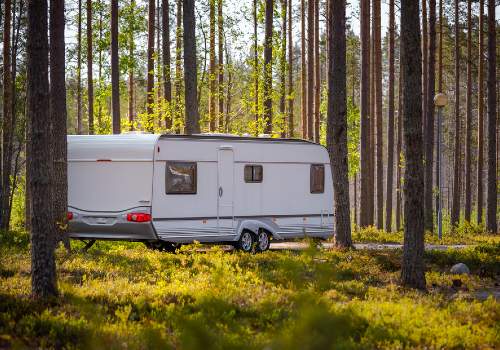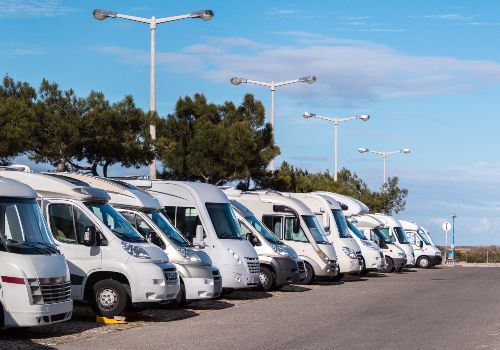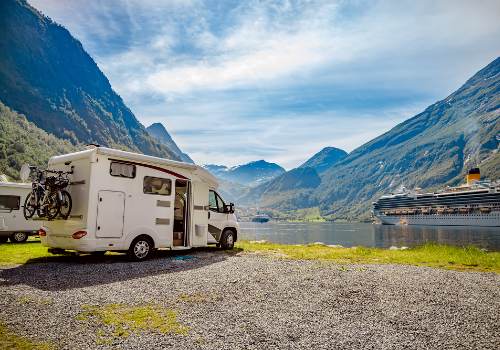Interest in RVs is exploding, with endless information about sales, demographics, and the overall lifestyle.
Every aspect of the recreational vehicle industry shows growth, and knowing what is going on in the RVing world can help you navigate it more safely as a buyer, owner, or seller.
Keeping up with the latest facts and trends can get confusing, so check out this RV Facts Guide, where I compile stats from across the industry into one easy read!
Current RV Sales Facts
Across the board, RV sales are up in every segment of the population, not just for retirees. From 1980 to the present, the percentage of American RV owners is almost 60% higher.
A 2019 RVIA (Recreational Vehicle Industry Association) study revealed that the RV industry’s economic impact was $114 billion, creating upwards of 600,000 jobs.
RVIA stats comparing February 2019 to the same month in 2020 show a 1.9% increase in RVs shipments to dealers right before the COVID-19 outbreak.
Even with many manufacturers and dealers shut down for months, RV sales kept increasing throughout the year.
The owner of Marathon Coach, Steve Schoellhorn, predicted their company would have a 30% increase in sales for 2020.
And Airstream saw its sales jump 11% in May 2020 alone, according to the company’s CEO, Bob Wheeler.
With over 7,000 recreational vehicle dealerships in the US, there is easy access and high demand for people to buy a camper to enjoy safe family vacations.
RV dealers in the US now create $23 billion in revenue, with a steady 6.6% increase in annual growth since 2013.
According to research, the 2019 global RV market was at $51 billion (USD), and by 2026 predictions expect it to reach $77 billion (USD).
A University of Michigan study points out that one in seven households have serious intentions of buying a recreational vehicle, with the age of first-time RV buyers getting younger.
Statistical surveys put out data that shows sales of RVs for people under the age of 45 was 35% for the months April-June of 2020, an 8% growth over the previous three months.
In 2008, the US financial crisis put a damper on RV sales, and the next year, under 170,000 campers were shipped to dealers across the country.
From 2009-2017 as the economy recovered, the run on RV sales was continuously steady. By 2014, 356,700 RVs went out to dealers. By 2017 the recreational vehicle industry had a 200% increase in growth.
In Michigan alone, the RV sales and service sector bring in over $712 million, with many states showing similar stats.
While initial RV sales were looking stagnant in early 2020, things took a surprising turn once pandemic lockdowns eased and stir-crazy households wanted a safe escape.
All age groups began jumping on RV ownership, and the RVIA expects 46 million Americans to go on an RV trip within the next year.
July 2020 saw RV shipments soar 53.5%, which is the best performance seen in the industry in 40 years!
Which RV Types Are Most Popular?

Of all the RV types on the market, the biggest seller is the traditional travel trailer, showing a 76.4% surge in sales.
RVIA stats show that 88% of recreational vehicles sold are towable, leaving 12% in Class A, B, or C motorhome category.
All towable campers, including pop-ups, fifth-wheels, and teardrops, have a 56.6% increase in sales over 2019.
Sales of Class B motorhomes were up 90% in June 2020 over June 2019, with an overall growth of 40% for the year.
Motorhomes sales have grown by 27.4% over 2019. Even luxury Class A motorcoaches have seen an increase in orders as well-to-do households jump on the RVing trend.
Folding campers (pop-up tent trailers) sales are up 28%, with younger families finding them an affordable camping option.
Even sales of park model RVs, tiny house-like trailers made for stationary use, have grown 10%.
Facts On Average RV Prices
You can find new RV models that range in price from around $8,000 to those exceeding $1 million.
The most expensive RV costs $3 million — the EleMMent Palazzo Superior from Marchi Mobile, but most Americans purchase campers in the $15,000-$150,000 range.
What makes new RV purchases so enticing is the 20-year financing, which puts payments at an affordable level for many budgets.
A 20% downpayment is a typical requirement to secure a loan, and the average RV monthly payment is $600 for a $90,000 camper.
Stats for 2017 show that dealerships made over 200,000 RV loans, with common sense indicating that 2020 loan figures are even higher.
As with cars, RV value drops about 25% as soon as you drive it off the lot, leading many buyers to look at used campers.
Sales for used RVs through dealerships and private sellers have been through the roof during the second half of 2020.
Latest Facts on Who Is RVing

94% of all RVers travel with a group of 2-7 people, making couples and families the driving force behind RV ownership or use.
According to RVIA, around 8.9 million US households own an RV, with buyers between the ages of 35-44 making up almost 21% of sales. RV sales to those in the 25-34 age range now reach 8%, a quick 3% increase over previous years.
About 25 million people take to the roads in recreational vehicles each year between RV owners and people who rent or borrow. That’s a large chunk of the 2017 stat total that shows 41.8 million people camping in some fashion.
Almost 40% of RVers having children under 18, and stats show that around 25% of the camping population are kids.
While retirees make up a large portion of RV owners, the facts show that most RVs belong to people between the ages of 35-54.
This high number of median-age owners stems from the fact that 90% of them feel a camper is the best way to travel with children, and 54% of them also love the ability to bring their pets on vacation.
Another growing segment of the RVing community is those that camp full-time. One million Americans currently RV full-time, most without owning a residence outside of their camper.
With remote job opportunities readily available due to the pandemic, people are hitting the road in an RV to escape the bills, responsibilities, and boredom of traditional living in an apartment, condo, or home.
Facts show that most RVers use their camper only 3-4 weeks per year, with a small number taking seasonal or extended vacations and the rest going full-time.
Recreational Vehicle Owner Demographics
The average RV owner is:
- 49-years-old
- Married
- Has a $68,000 yearly income
- Has kids
- Owns a home
- Travels three weeks a year
While there is a large increase in RV ownership in the 25-34 age bracket, a recreational vehicle’s high cost tends to keep sales down while this group focuses more on homeownership or paying down student loans.
Overall, RVers in their 20’s make up only 1% of ownership, according to a study of RV Association members done in 2014. As of 2020, this number is sure to have increased along with all age-demographic sales stats.
RV Manufacturers – Who Are They?

RV manufacturer brands have consolidated over the past 20 years, with companies like Thor owning many campers selling under different names.
New, niche RV brands are coming out that cater to small markets, such as off-road camping or off-grid living.
The largest number of RVs are made in Elkhart County, Indiana.
83% of all RVs sold in the US and Canada come out of Indiana (60% from Elkhart), with Oregon and California manufacturers creating another 15%.
The RV industry plays a massive role in the American economy, employing hundreds of thousands of workers for sales, manufacturing, service, and support.
Michigan generates over $1.6 billion for RV suppliers and manufacturers. Camping also makes up 10% of all pleasure travel in Michigan.
RV makers are going non-stop to keep up with current demand after the pandemic shutdown. Experts predict RV shipments in 2020 to hit 425,000 units, an increase of 4.5% over 2019.
RV shipments for 2021 are expected to hit more than 510,000 units, according to a report from ITR Economics for the RVIA.
Which States Sell the Most RVs?
Finding RV data per state is difficult, but tracking RV shipments is an excellent indication of sales. In 2019, new RV shipments were highest in Texas who received 10.3% of the supply.
California came in second with 8%, followed by Florida at 5.7%, and Ohio and Michigan with both at 4.4% of RV shipments.
Another interesting fact is that US recreational vehicles are big sellers to other countries. Canada imports 90% of RVs the US exports, with Japan, Korea, and China taking up nearly all the rest.
RV Support Industry Statistics
A single RV requires many support companies for the materials, furniture, plumbing, heating, mechanical, and electrical components.
In Michigan, RV support companies brought in over $3 billion to the economy in 2019, according to RVIA.
With over 12,000 RV-related businesses in operation across the United States, the RV industry’s impact on our economy is enormous. Workers generate around $4.9 billion in payroll alone.
The hospitality side of the RVing industry also plays a massive role in revenue generation.
Campgrounds, travel/truck stops, repair centers, and other RV-specific needs add to the whopping $114 billion that the RV industry brought to the US economy in 2019.
Facts on RV Campgrounds

Across the US, there are currently around 16,000 listed campgrounds for RVers. Add to that the thousands of off-grid camping options found on private and public land and the myriad of mom and pop campgrounds that don’t advertise.
According to RVIA, $1.1 billion was spent in Michigan for RV campgrounds and travel in 2019, spread over the 1,354 licensed RV parks in the state.
National parks offer 130 affordable RV campgrounds. State parks also provide RV camping, like Florida, which offers 54 choices.
If you were wondering, statistics show that the most popular place RVers visit is Yosemite National Park.
Cost Statistics Between RV Travel vs. Hotel
Want to Connect With a Community of Over 1,078 RV Enthusiasts?
Vacations, especially for families, can be expensive. Adding up the cost of hotel rooms, airline tickets, and eating out can bust a budget quickly.
RVers using their camper for vacations reduce costs 23-59%, which is a significant saving that easily justifies investing in a camper purchase.
With the current health climate, RVers also appreciate the priceless benefit of having complete control over their environment. There is no guessing how clean the bathroom or bedding is when you take care of it yourself.
About 89% of RV owners state that using a camper is much easier than tent camping. It’s much easier to have everything you need in a trailer than packing partial belongings into a car and moving in and out of hotel rooms.
RVIA did a study with a travel party of four people in an RV versus other vacationing options and found the average cost savings was 21%-64%.
RVers take more trips that were otherwise financially impossible, bolstering the appeal of RV ownership.
For RV-owning households, 90% still take a traditional vacation along with a minimum of three RV trips throughout the year.
Facts on Environmentally-Conscious RVing Trends
Most RVers have a tremendous appreciation of the outdoors and nature, leading them to be environmentally-friendly in their actions.
Stats from Go RVing show that solar panel installation on campers is near 20%, with more people investing in this power source every year.
Many RVers use composting toilets, water-conservation techniques, and extreme waste-control measures to keep their ecological footprint low.
While gas-guzzling motorhomes and heavy-duty trucks consume fuel and exhaust harmful chemicals, there are plenty of options with less impact available for purchase.
The RV industry continually upgrades materials and design to create more efficient campers in fuel economy, power usage, and water management.
High-efficiency appliances, integrated solar power systems, lighter-weight materials, and cleaner-burning engines are becoming the norm.
Studies show that the carbon footprint of four people traveling by RV is much less than a typical flight and rental car vacation.
For people full-timing in an RV, the reduction of energy use, waste accumulation, overall fuel use, and water use is massive compared to living in a home and driving a car everywhere.
A comparison study found that a camper uses significantly fewer resources to maintain than living in an apartment, condo, or single-family home.
Speaking of driving, RVers can lower emissions by keeping to 55 MPH during travel. While going 55 may seem annoying, you’re helping the environment and maintaining better control over your camper.
So slow down, smile, and wave to all the automobiles and wasteful RVers blowing past you going 70 MPH!
Random RV Facts You Need to Know
Before the 1960s, when the term RV or recreational vehicle came into play, people called such vehicles a camper or trailer. Now people are more specific when describing their RV, such as calling them a fifth-wheel, Airstream, or motorcoach, etc.
20% of RVers utilize camping locations that aren’t a campground. Boondocking off-grid and overnighters at Walmarts or other retail establishments are common in the RV community.
“Overlanding” is becoming an RV industry focus, with manufacturers increasing output and design upgrades on campers made for more rugged, off-road terrain.
According to Cummins, it takes 30 days of storage for the fuel inside an RV generator to gum up and varnish the fuel system, so run your generator at least every two weeks to prevent issues.
As of September 2020, 73% of the countries largest school districts are using remote learning. That means 8 million students can learn from a campsite, so families can enjoy more time using their RV.
Studies show that RVers as a group are happier and healthier than the general population. Benefits include less fatigue and stress, along with a boost in the immune system from more exposure to sunlight, fresh air, and nature.
The first camper came not long after the introduction of the Model T Ford 120 years ago. Historians cite the year 1910 as the first time mobile trailers became available.
April is the most popular month to go Rving, followed by June and July.
Final Thoughts
Knowing the latest RVing facts and statistics are helpful when you want to stay ahead of the crowd.
With campgrounds and vacation destinations for RVers becoming more popular as camper sales rise, you can plan accordingly to secure a spot.
I hope you enjoyed this article, and it helps you make more informed RV decisions!
"Man cannot discover new oceans unless he has the courage to lose sight of the shore."
-- Andre Gide











